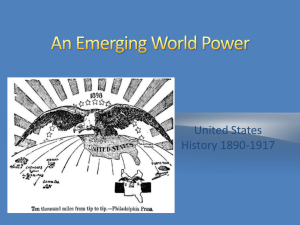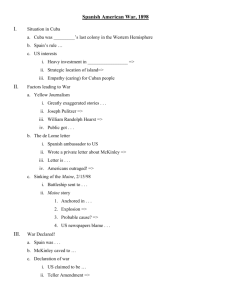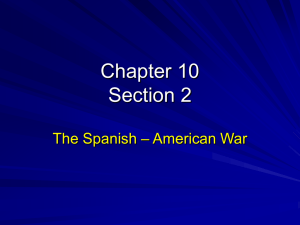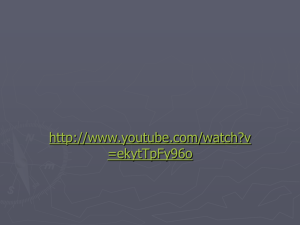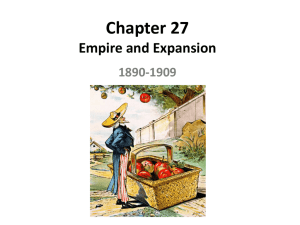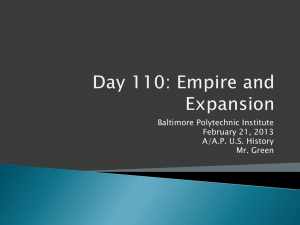United States Imperialism
advertisement
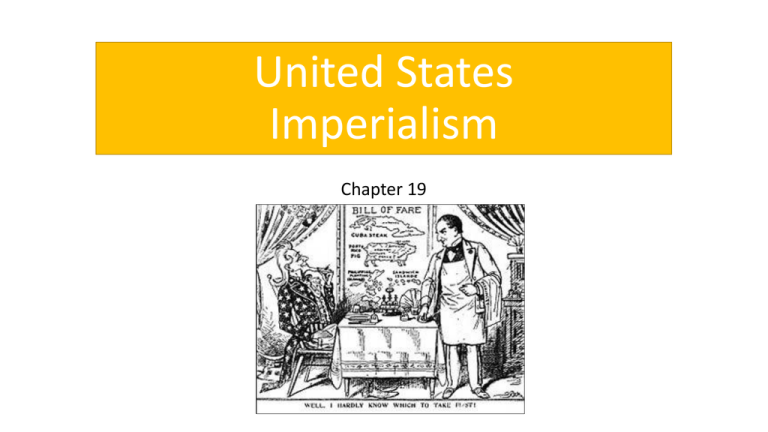
United States Imperialism Chapter 19 Stirrings of Imperialism • The New Manifest Destiny • American attention shifted to foreign lands for the following reasons: • Fear that natural resources would dwindle & must be found abroad • Importance of foreign trade & a desire for new markets • Fear that America would be left out of the spoils of imperialism due to Europe • U.S. justified expansion by applying theory of Social Darwinism to imperialism Stirrings of Imperialism • Josiah Strong’s Our Country: Its Possible Future and Its Present Crisis (1885) promoted Anglo-Saxon’s duty to help less fortunate people. • Admiral Alfred Mahan wrote The Influence of Sea Power Upon History (1890) promoted the idea that the U.S. needed to have: • Foreign commerce • A strong Navy to defend trade routes • Colonies to provide raw materials & military bases White Man’s Burden Stirrings of Imperialism • Hemispheric Hegemony • Secretary of State James Blaine sought to expand U.S. influence into Latin America through the Pan-American Congress. Stirrings of Imperialism • Hawaii & Samoa • Americans that settled Hawaii beginning in 1810 had come to dominate it politically & economically • Brought disease that decimated the native population. • U.S. Navy negotiated the use of Pearl Harbor as a naval base (1887) • Sugar became the island’s main crop that could be traded tax free. Stirrings of Imperialism • When the U.S. eliminated duty-free sugar, American planters felt the only way to survive economically was to join the United States. • In 1893, a revolution was staged against nationalist Queen Liliuokalani. President Harrison signed an annexation agreement that was eventually approved during the Presidency of Cleveland in 1898. • Samoa had served as a station for U.S. ships since the mid-1800s. In 1899, the U.S. & Germany split control over the islands. War with Spain • Controversy over Cuba • Cuba had sought independence from Spain in 1868 & again in 1895. • Spanish General Valeriano “the butcher” Weyler used harsh tactics & established concentration camps, which caused public sympathy from the U.S. Press & citizens. • Joseph Pulitzer’s New York World & William Randolph Hearst’s New York Journal used “yellow journalism” on the Cuban crisis to compete for circulation. War with Spain • Cuban Americans urged independence for Cuba (Cuba Libre) • President Cleveland proclaimed U.S. neutrality, but President McKinley protested Spanish conduct. • The Spanish responded by removing Weyler. War with Spain • Two events in 1898 ended a peaceful resolution: • De Lome Letter – a letter from Spanish minister to the U.S., Enrique Dupuy de Lome, was intercepted & published, which was critical of President McKinley. • “Remember the Maine” – a mysterious explosion in Havana Harbor of the U.S. battleship Maine was blamed immediately on Spain & resulted in a public outcry for war against Spain. War with Spain • “A Splendid Little War” • U.S. Secretary of State John Hay called the war this because: • It lasted only five months (April-August) • Few U.S. battle deaths occurred although 5,000 died as a result of disease • U.S. expanded its empire in the Caribbean & Pacific • The war effort was hampered by: • Army supply problems • Lack of U.S. military experience • Use of volunteer units (Teddy Roosevelt’s Rough Riders) • Racial discrimination against African-American soldiers War with Spain • Seizing the Philippines • Theodore Roosevelt, the Secretary of the Navy, strengthened the Pacific Fleet & ordered Commodore George Dewey to attack Spanish forces in the Philippines. • By May 1898 Manila Bay had been captured. • The war to free Cuba had become a war to strip Spain of its colonial possessions. War with Spain • The Battle of Cuba • American forces attacked the Spanish fleet in Santiago Harbor & eventually captured Santiago & Puerto Rico. • At the Battle of Kettle Hill a volunteer unit led by Theodore Roosevelt known as the Rough Riders was victorious. • An armistice with Spain in August ended the war. Spain recognized Cuban independence, ceded Puerto Rico & Guam to the U.S., & accepted occupation of the Philippines. Puerto Rico & the United States • The annexation of Puerto Rico produced little controversy. The American military controlled the island until the 1900 Foraker Act created a colonial government with an American governor, a 2chamber legislature, and a US right to amend/veto any legislation. • In 1917 Congress passed the Jones Act that made Puerto Rico a US territory & Puerto Ricans American citizens despite cries for their own independence. The Debate over the Philippines • Debate over the Philippines was different because it was not in the Western Hemisphere. It also was densely populated and far away. President McKinley was reluctant but believed no other alternative existed. It could not be returned to Spain or left for another imperialist nation, and the Filipinos were “unfit for self govt”. • The war with Spain ended in 1898 with the Treaty of Paris. The US paid $20 million for the Philippines. Fierce resistance occurred in the US over ratification. • Anti-imperialists (under Anti-Imperialist League) were opposed because imperialism was immoral & industrial workers feared cheap labor entering the U.S. The Debate over the Philippines • Ratification was supported by imperialists such as Theodore Roosevelt who saw the new U.S. Empire as a means to reinvigorate the nation & dominate Oriental trade. • The treaty was ratified in 1899 because antiimperialist Democrat William Jennings Bryan wanted to make it an issue in the 1900 election. Bryan ran against McKinley. McKinley won & the election became a referendum on war that showed the American people supported imperialism. The Republic as Empire • Governing the Colonies • Hawaii, Alaska, and Puerto Rico received territory status (residents became US citizens) • The U.S. military remained in Cuba. After a Cuban constitution failed to mention the US, Congress passed the 1901 Platt Amendment that would bar Cuba from making treaties, gave the U.S. the right to intervene in Cuba (little political independence given), & American capital bought up much of the Cuban economy and dominated it. The Republic as Empire • The Philippine War • U.S. subjugation of natives led to a long, bloody war with insurgent independence fighters. US used same brutal tactics that it had opposed Spain using in Cuba. • The Rebellion was led by Emilio Aguinaldo with a large popular following. By 1902 brutal and savage US tactics had changed American public opinion of the war, but by then war already over (Aguinaldo captured 1901). The Philippine War proved much more costly than the SpanishAmerican War. • Power was given to US administrator William Howard Taft who believed the U.S. mission was to prepare Filipinos for independence. Philippines were given broad local autonomy. Trade with the U.S. grew and islands came to almost depend on US markets. The Republic as Empire • The Open Door Policy • The Philippine occupation strengthened US interest in Asia and Chinese trade • European nations were carving up China for themselves; McKinley wanted to protect US interest in China without war. Secretary of State John Hay proposed in 1898 “Open Door notes” to European nations allowing access to China but would give no nation special advantages. Allowed free trade without creating a colony or military involvement. • The Boxer Rebellion arose against foreigners in China. Siege of foreign diplomatic corps resulted in McKinley and Hay participating in quelling this rebellion. The Republic as Empire • A Modern Military System • War with Spain showed the weakness of the U.S. military system in training, supply, & coordination. McKinley appointed Elihu Root as Secretary of War to overhaul U.S. forces. • Root enlarged the army, created federal standards for a National Guard, created officer training schools, created Joint Chiefs of Staff to advise the Secretary of War & to supervise military establishment. The modern military system was created by the turn of century. 1. How does the cartoonist portray President Theodore Roosevelt? 2. Why is "The World's Constable" a good title for this cartoon?
